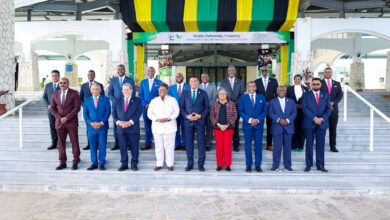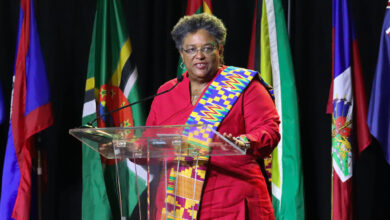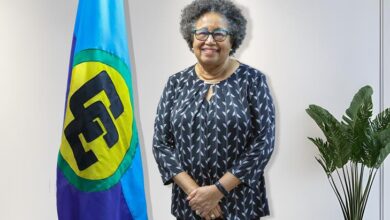(Barbados Government Information Service) Fourth, fifth and sixth form students of the Alleyne School in Barbados now have a better understanding of the history of the Caribbean Community (CARICOM), and how it has evolved over the years.
They were given a perspective at a ceremony to kick off the Barbados leg of the I AM CARICOM (#iamcaricom) I am campaign on Wednesday at the school, by Ambassador to CARICOM, David Comissiong. The campaign was launched by the CARICOM Secretariat in the margins of the 10th Meeting of the CARICOM Committee of Ambassadors held in Guyana, on 21 November, 2019.
Witnessing the launch were Principal Julia Beckles; Deputy Principal Antwone Holder; Senior Foreign Service Officer in the Ministry of Foreign Affairs, Sandra Gittens; Head of the General Studies Department Heather Browne; and Head Boy of the School, Shem White.
Ambassador Comissiong told the students:
“The purpose of the I am CARICOM project is to reach all of the citizens and residents of the 15 member states of CARICOM and to bring home to all of the people of the Caribbean Community and to make a point to each of us … [that] look, you are a part of this intrinsic thing we call CARICOM.”
Stressing that CARICOM was much more than the Secretariat’s Headquarters in Guyana, he described it as an integration network that brings all of the countries in the region together, and gave birth to CARIFESTA and CARIFTA.
The Ambassador said that of the 17 existing CARICOM institutions, nine were located in Barbados, including the University the West Indies (Cave Hill), the Caribbean Examinations Council, the Caribbean Disaster Emergency Management Agency, the Caribbean Centre for Renewable Energy and Energy Efficiency, the CARICOM Regional Organization for Standards and Quality and the Caribbean Agricultural Research and Development Institute.
In his address, he took the students on a historical journey, describing Barbados as the father and mother of regionalism, noting that the political climate in the 1930s and 1940s created an environment that caused black Barbadian people to organize themselves into trade unions and political parties, with such leaders emerging as the Right Excellent Samuel Jackman Prescod, the Right Excellent Errol Walton Barrow and the Right Excellent Sir Grantley Adams.
Ambassador Comissiong noted that attempts to unite the region led to the birth of the Federation on 3 January, 1958, but insularity led to its subsequent collapse on 31 May, 1962. He added –
“It seemed impossible to get a political union like the Federation again. So [the Right Excellent Errol] Barrow came up with this idea … Let us not think of forming a political union; let us instead think of coming together to cooperate in terms of trade, economic development, [and] functional cooperation. And so, [the Right Excellent Errol] Barrow came up with this idea in 1965 of CARIFTA … We will trade with each other with no trade barriers; so whatever you produce in St. Lucia you can sell to Barbados with no taxes and no duties; it is a free trade area. And whatever we produce in Barbados, you in St Lucia will agree to accept. And, so it started with Barbados, Guyana and Antigua and launched in 1968.”
Ambassador Comissiong explained that subsequently, it was agreed among regional leaders to have a coordinated foreign policy that would better facilitate trade and protect nations from exogenous forces, hence a Common External Tariff was implemented and later the CARICOM Single Market and Economy.
At the end of the ceremony, the students were asked to research the institutions of CARICOM and were presented with I AM CARICOM T-shirts.
As part of the public education initiative, Ambassador Comissiong will make similar presentations to other schools in the island. (CL/BGIS)






